Luận án A study of dietary protein for growing californian rabbits in the Mekong delta of Vietnam
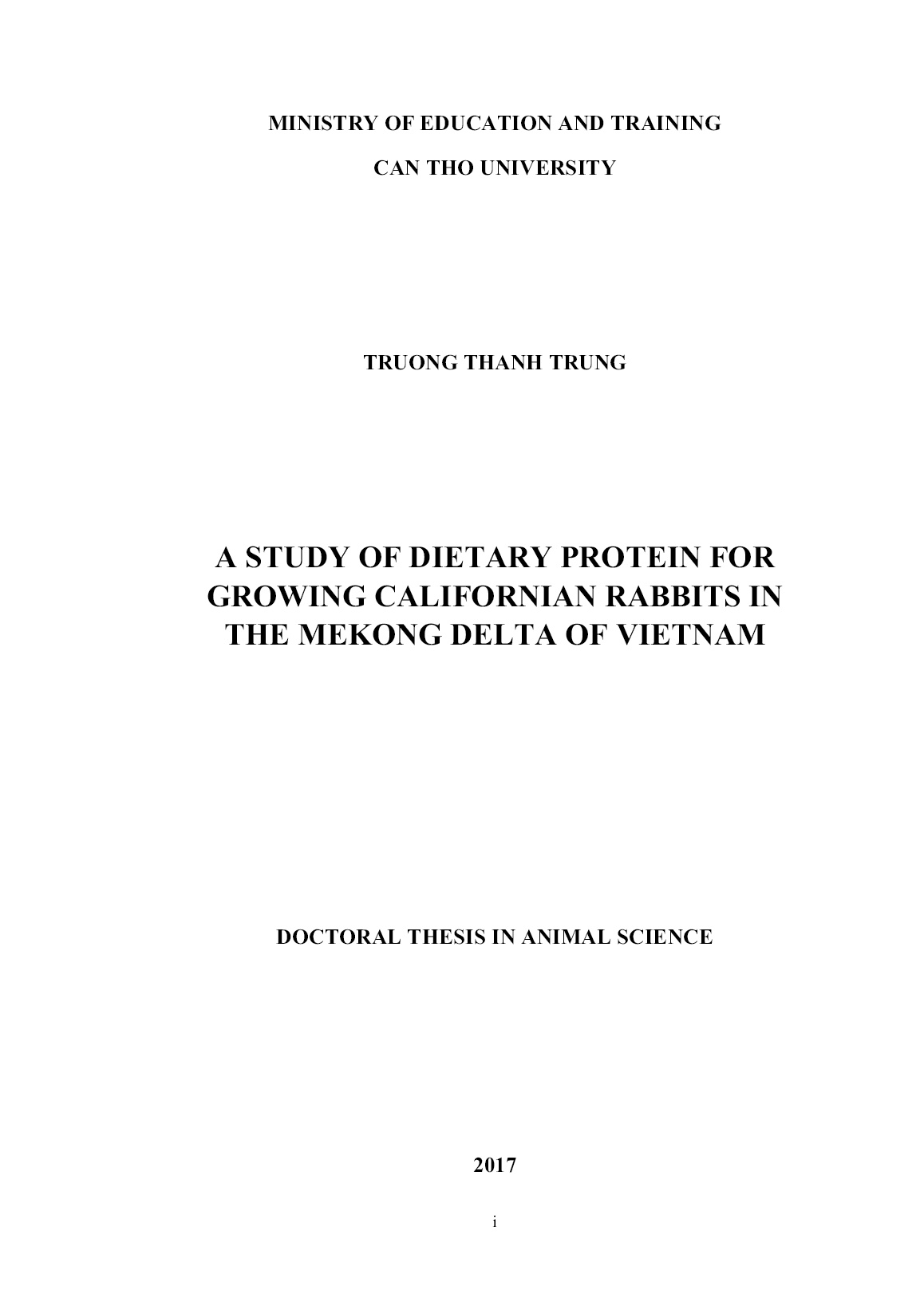
Trang 1
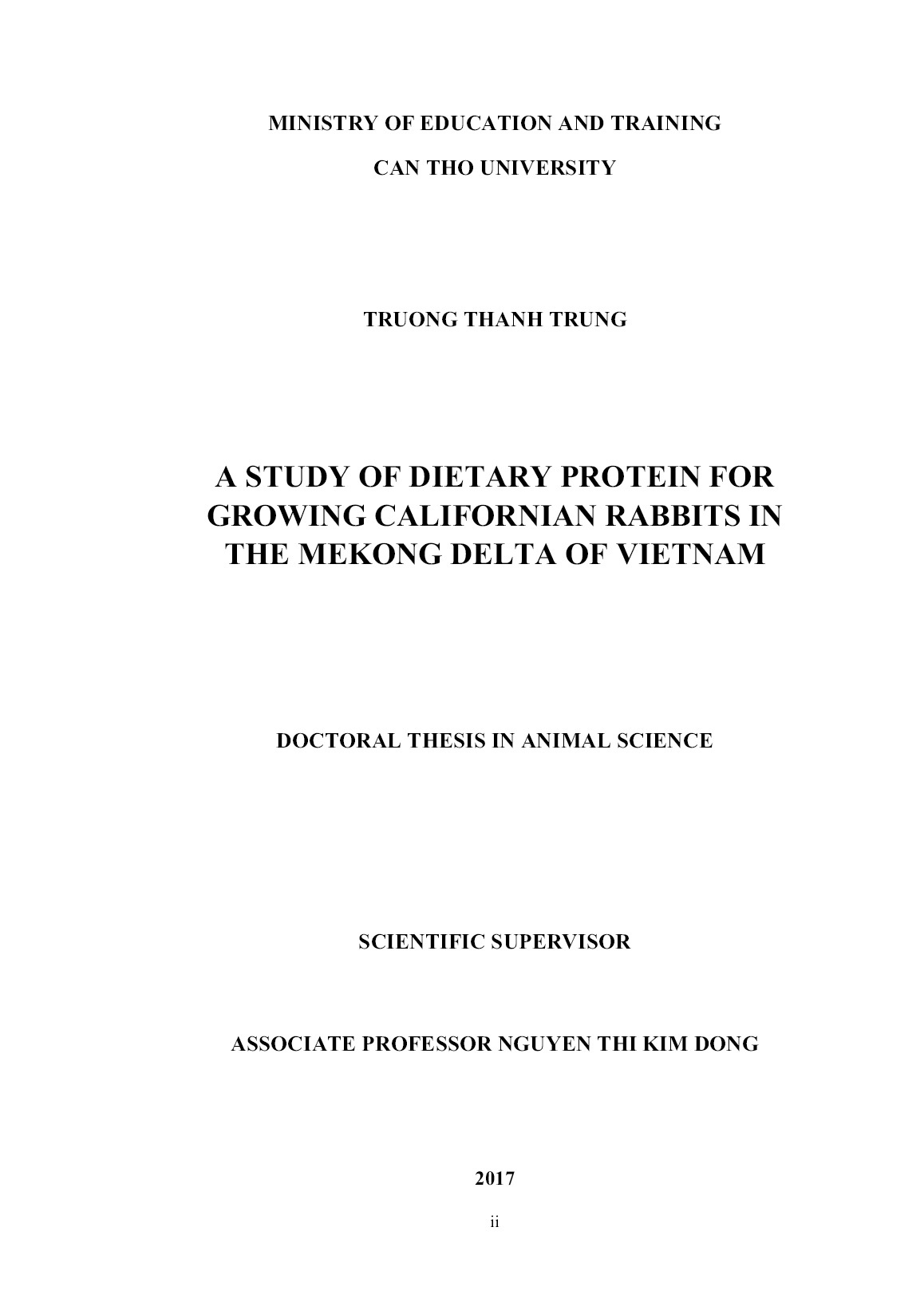
Trang 2
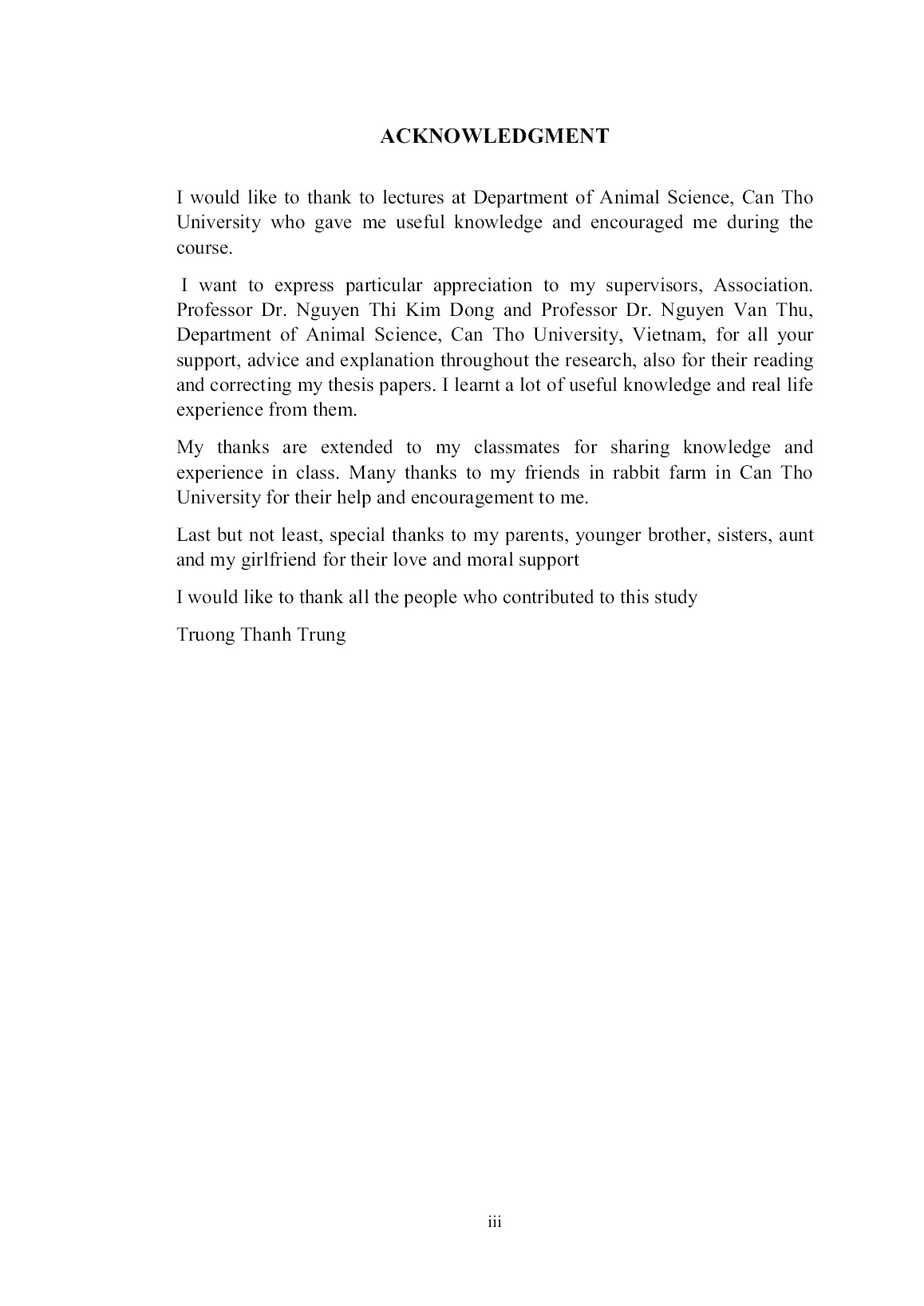
Trang 3
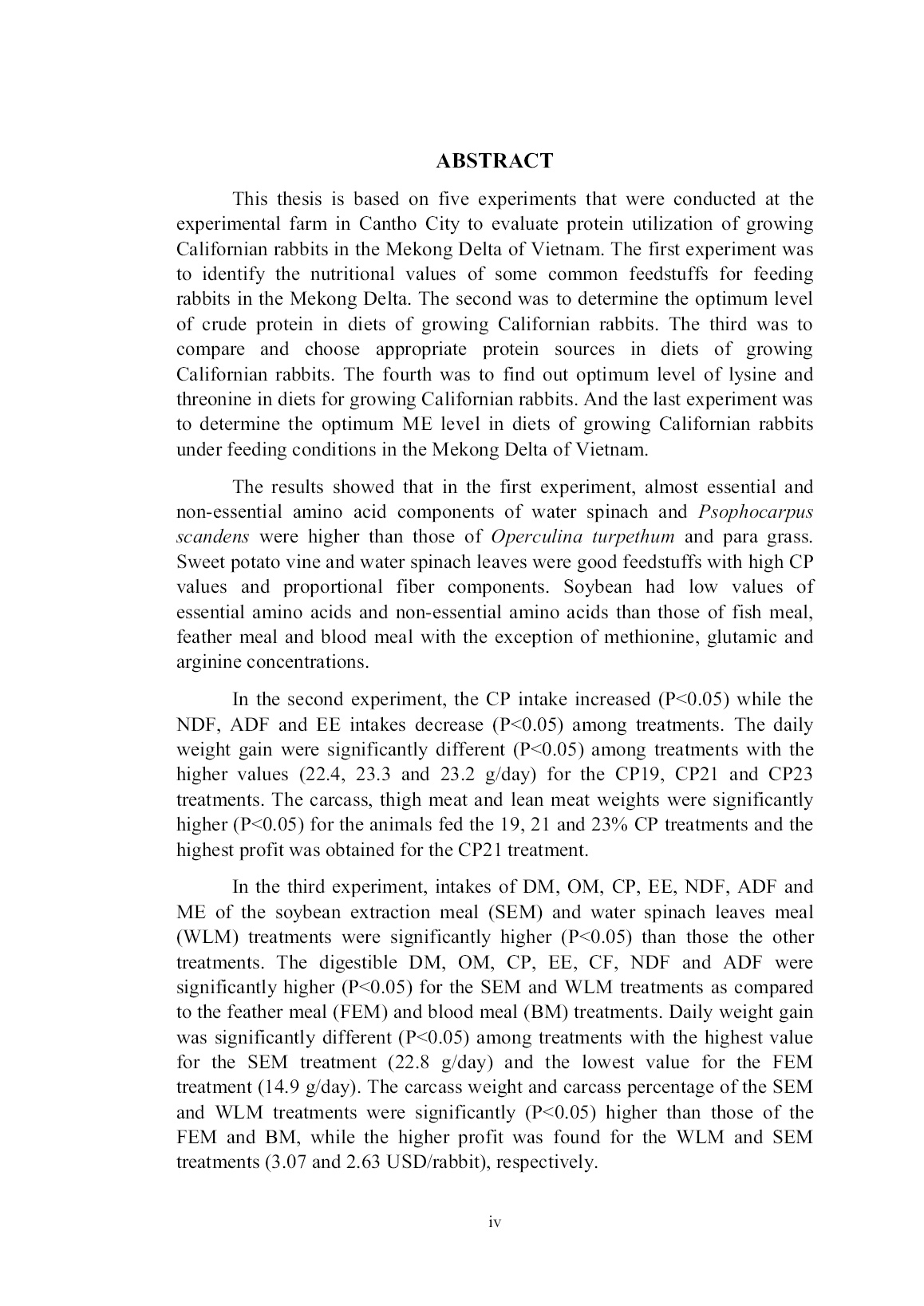
Trang 4
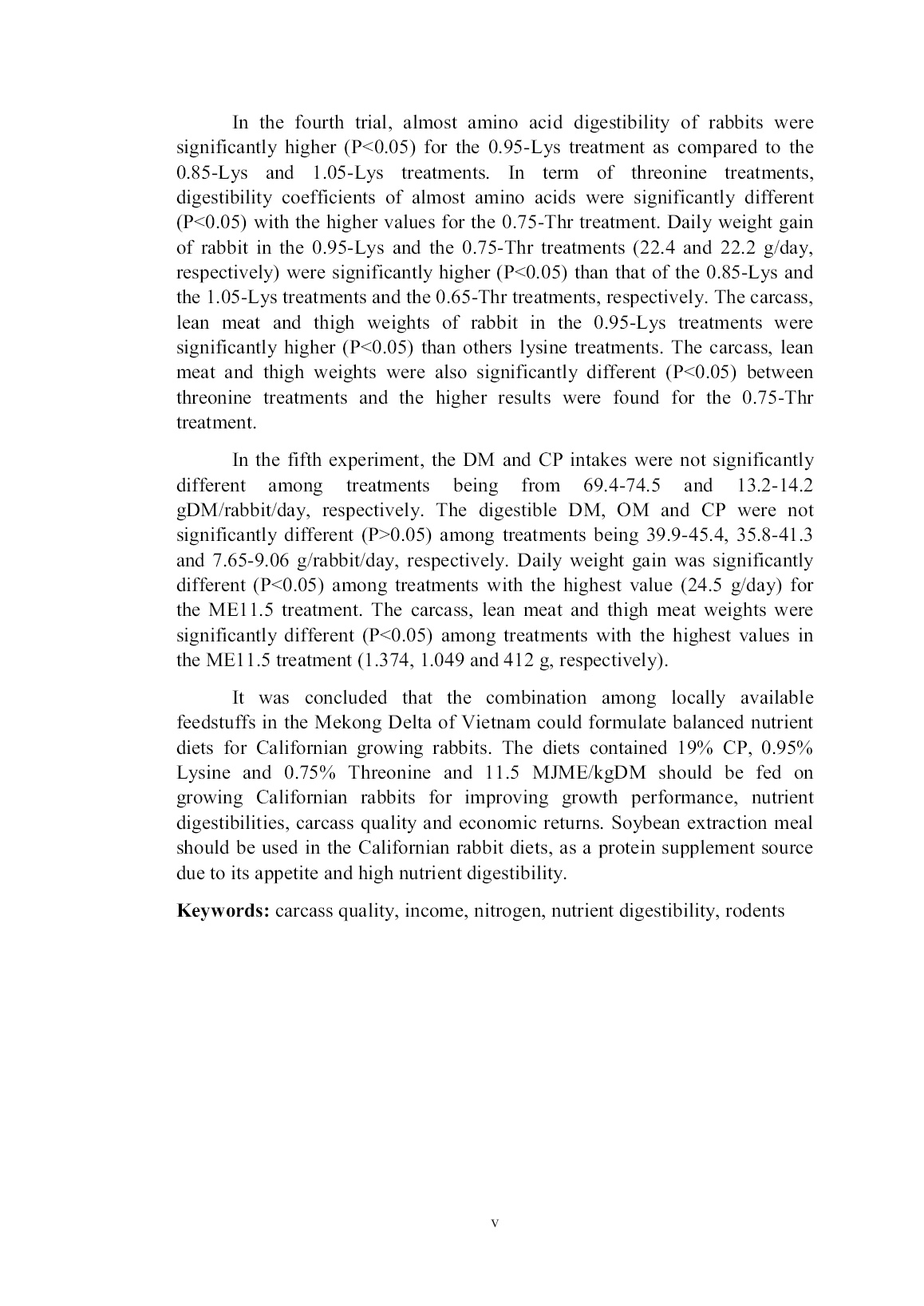
Trang 5
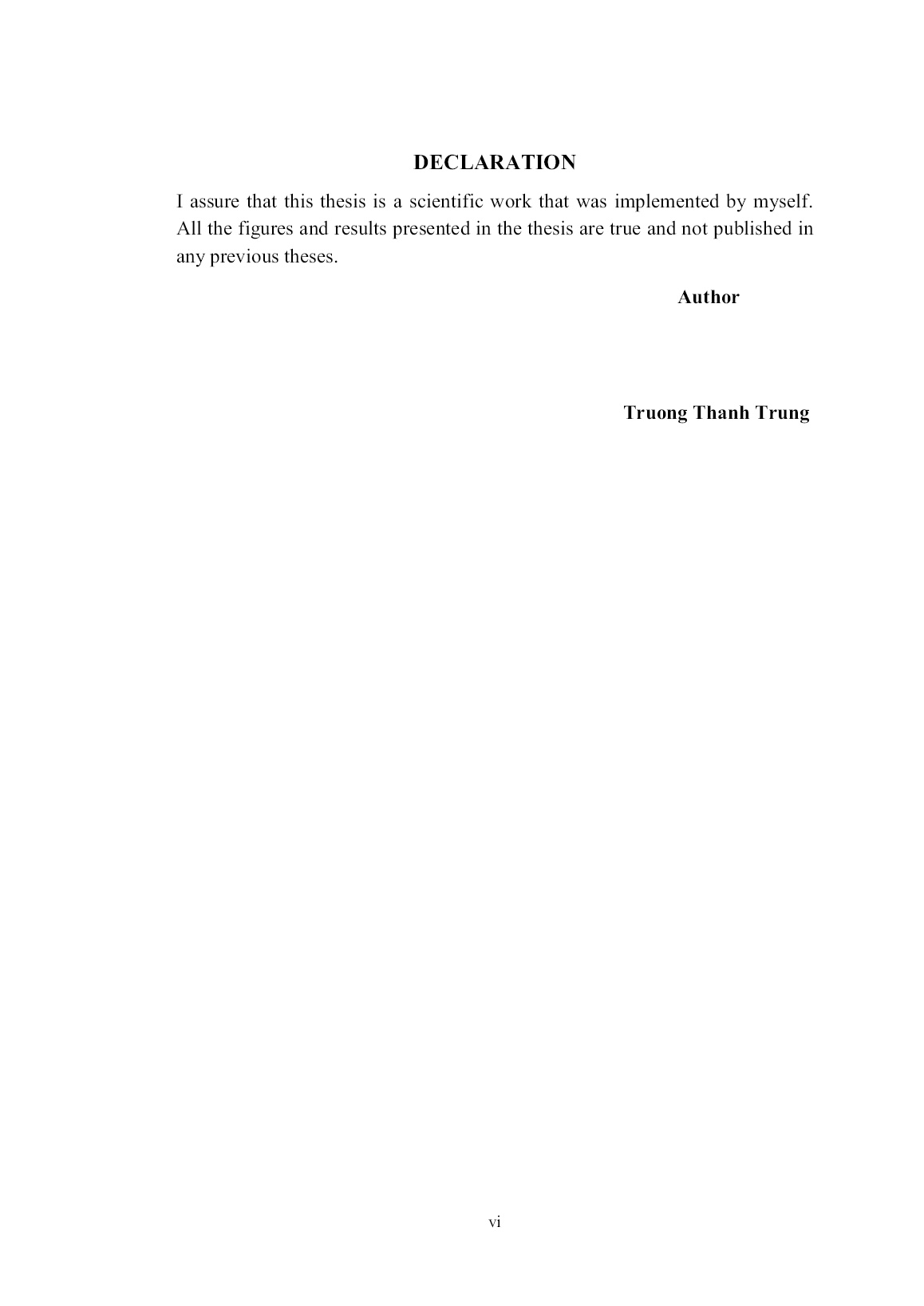
Trang 6
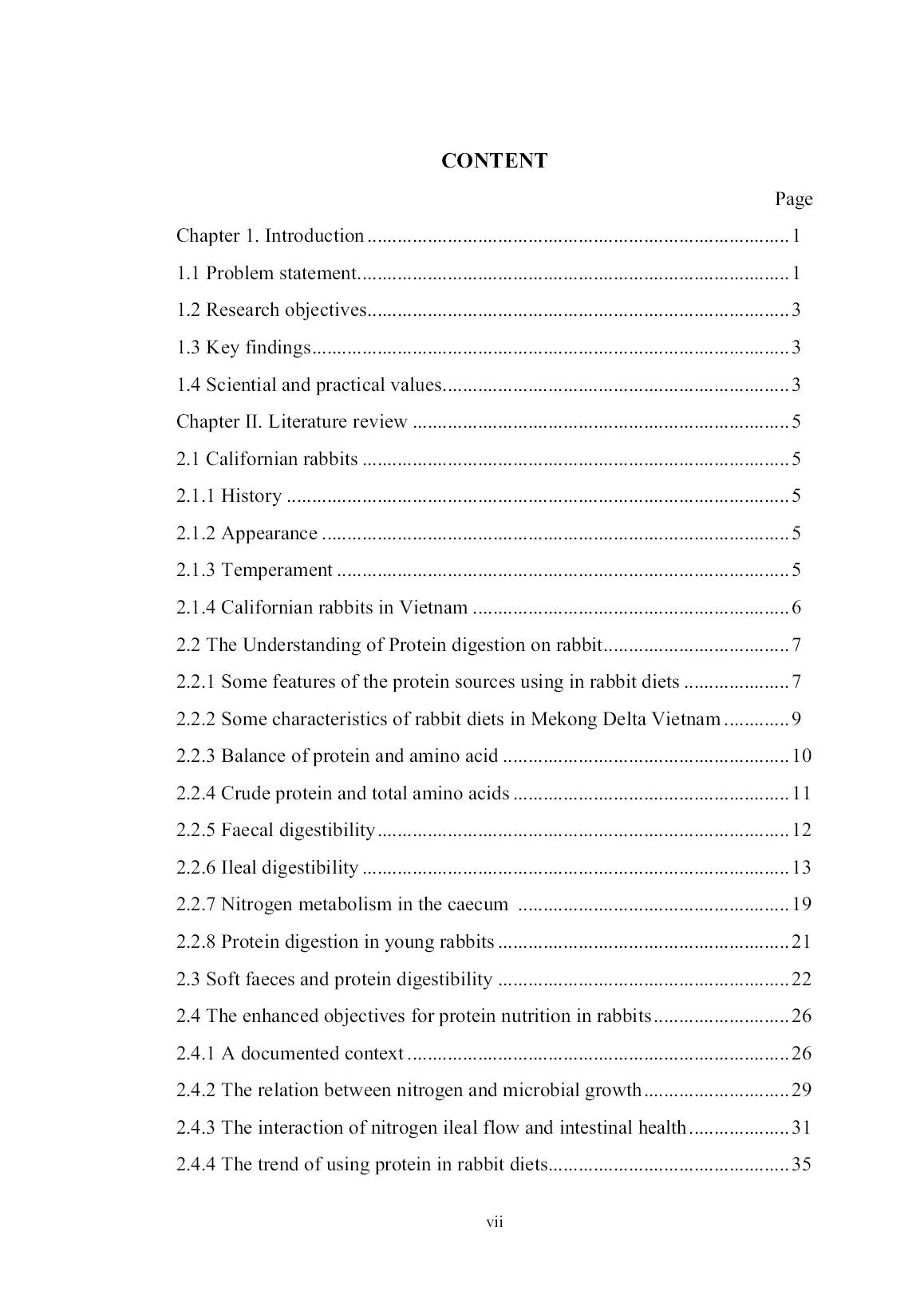
Trang 7
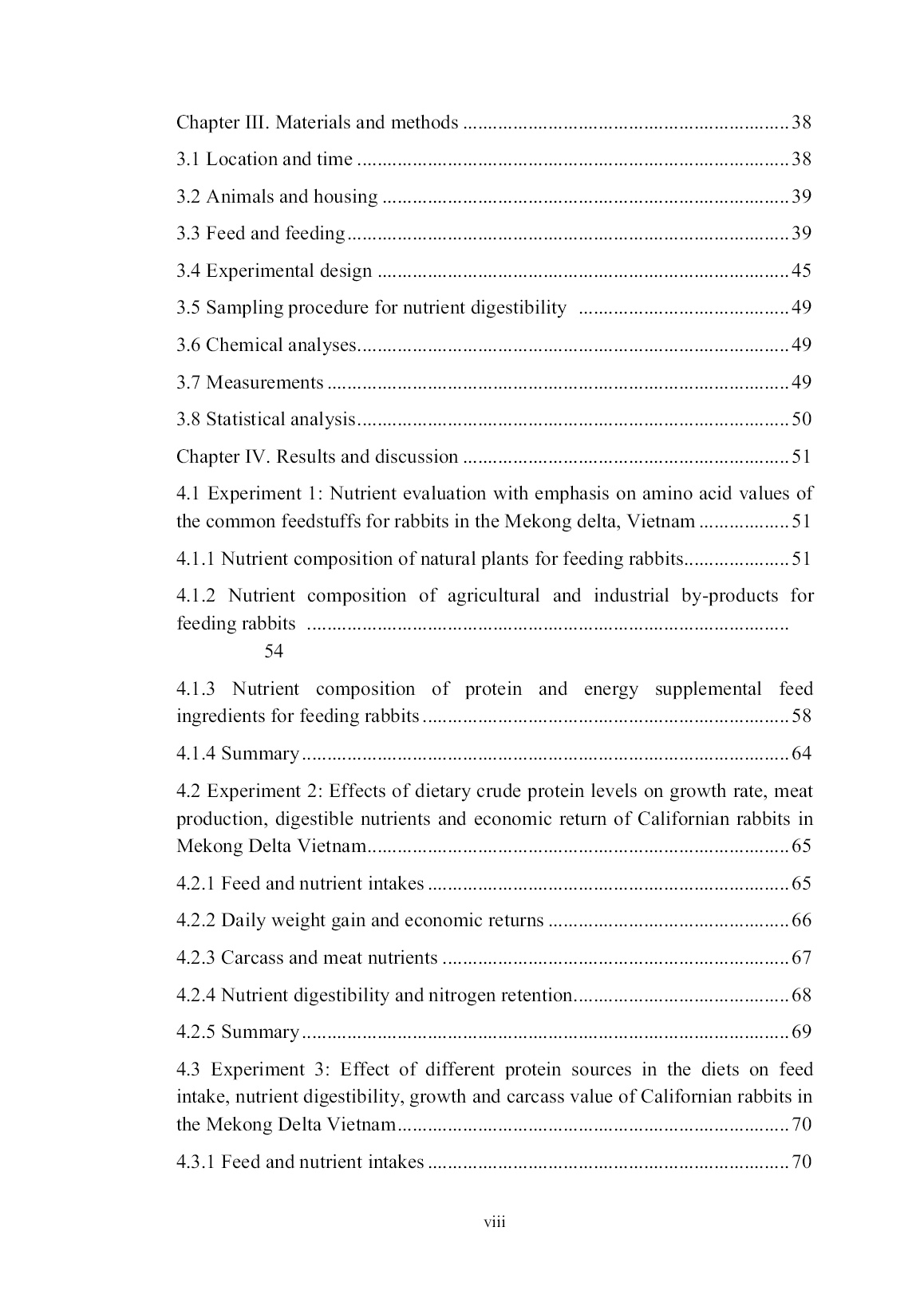
Trang 8
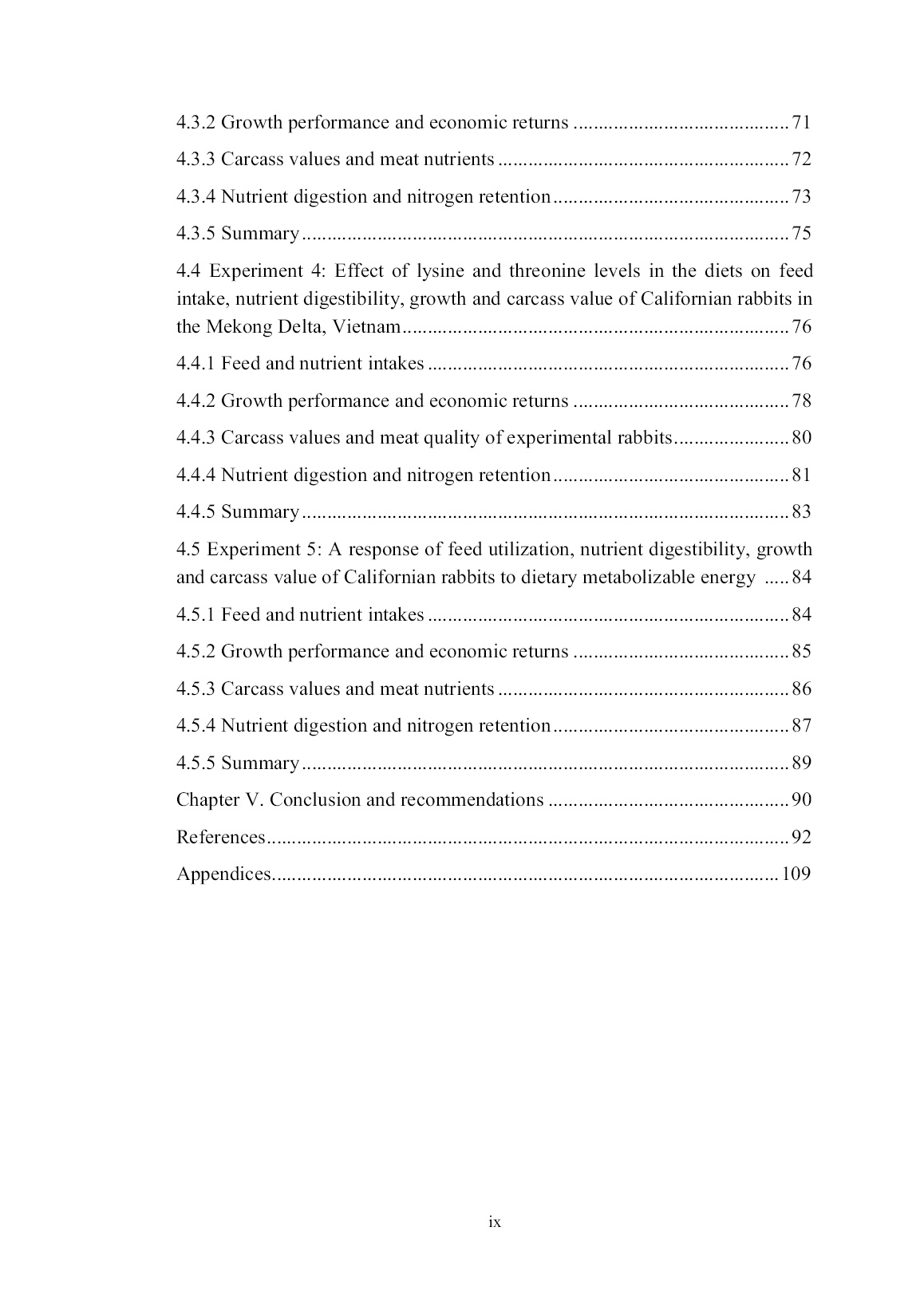
Trang 9
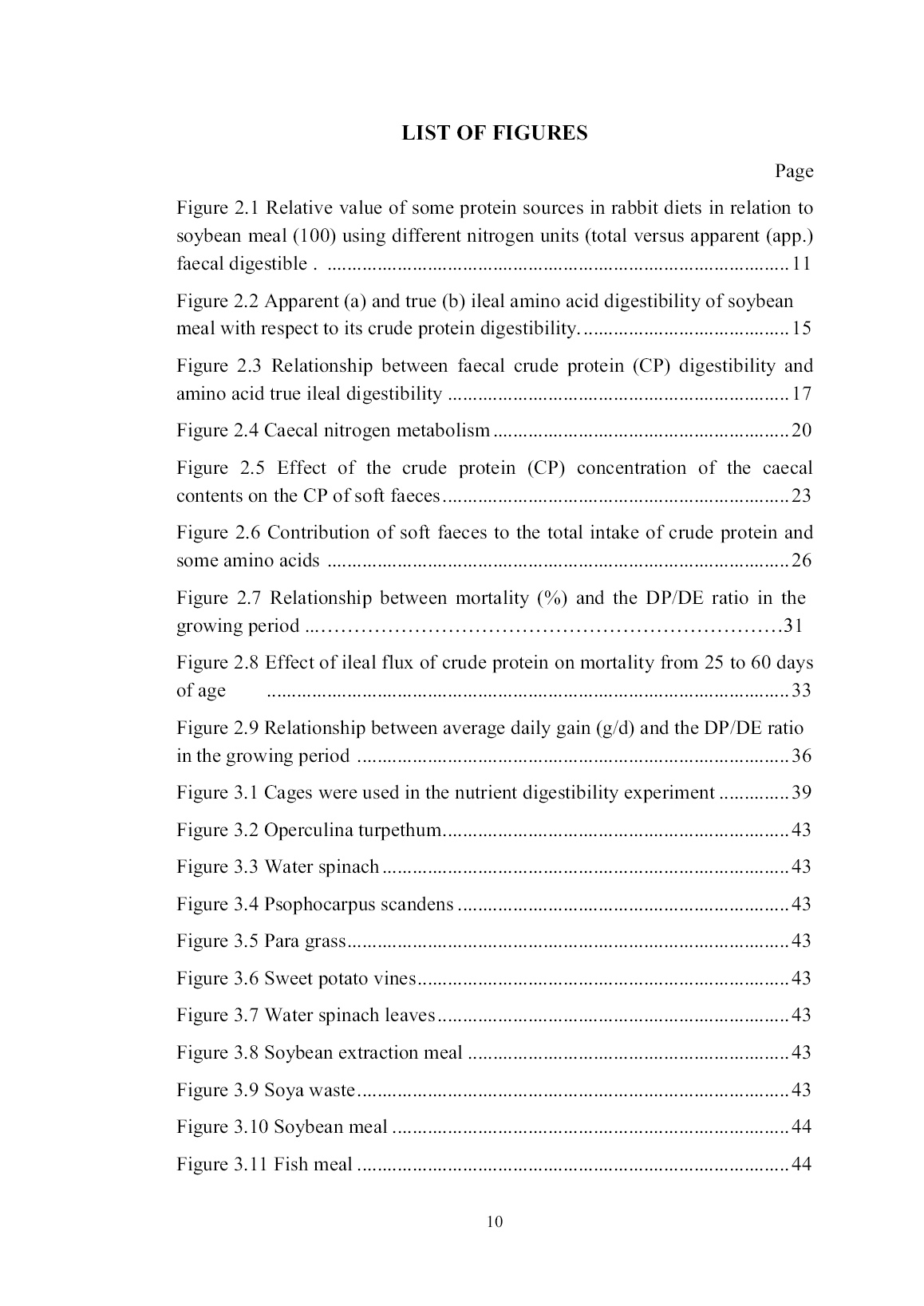
Trang 10
Tải về để xem bản đầy đủ
Bạn đang xem 10 trang mẫu của tài liệu "Luận án A study of dietary protein for growing californian rabbits in the Mekong delta of Vietnam", để tải tài liệu gốc về máy hãy click vào nút Download ở trên.
Tóm tắt nội dung tài liệu: Luận án A study of dietary protein for growing californian rabbits in the Mekong delta of Vietnam
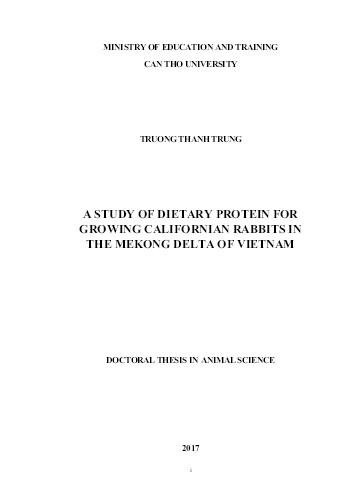
ormally used diets containing high proportion of roughage and low proportion of high-protein feeds for feeding rabbits. Thus, it was necessary to supply feedstuffs that contained high protein and energy in the diets for growing and reproduction rabbits. Soybean, fish meal, feather meal and blood meal were used to supply protein, while maize, broken rice and sweet potato tuber for energy supplementation. All feedstuffs including soybean, fish meal, feather meal, blood meal, maize and broken rice had high concentration of DM being 894, 830, 842, 905, 884 and 894 g/kg, respectively. A high CP content was found for the protein supplemental feeds with the highest values for feather meal and blood meal (801 and 829 g/kgDM, respectively). The ME content of these feedstuffs was not considerably variable from 10.8 to 12.1 MJ/kgDM. The CP, CF, NDF and ADF values of soybean in this investigation were slightly higher than those of soybean reported by Maertens et al. (2002) being 410, 62.2, 130 and 81.1 g/kgDM, respectively. However, CF value (105 g/kgDM) was in an agreement with result stated by NIAS (2001) ranged from 72.2 to 140 g/kgDM. The nutrient composition including DM and CP of fish meal in this investigation were slightly lower those of fish meal reported by NIAS (2001) (875 g/kg and 650 g/kgDM, respectively). The feather meal in this investigation containing DM, CP and EE was similar to findings of Ayanwale (2006) being 900 g/kg, 820 and 61.0 g/kgDM, respectively. The DM, CP, EE and CF of blood meal (905 g/kg, 829, 6.50 and 15.2 g/kgDM) were consistent with results of Balogun (1982) being 895 g/kg, 865, 5.90 and 16.3 g/kgDM, respectively. The DM, CP and ME concentration of soybean, fish meal, feather meal and blood meal were shown in Figure 4.5. 76 Figure 4.5 DM, CP and ME concentration of soybean, fish meal, feather meal and blood meal Soybean contained low value of essential amino acid and non-essential amino acid as compared to those of fish meal, feather meal and blood meal, with the exception of methionine, glutamic and arginine concentrations. The lysine and threonine of soybean in a previous study of Maertens et al. (2002) were 25.9 and 16.0 g/kgDM being higher than those of the results in a present investigation, however, methionine concentration (5.80 g/kgDM) was lower (11.0 g/kgDM). NIAS (2001) found that lysine, methionine and threonine of soybean were 27.1, 6.14 and 14.4 g/kgDM, respectively. Those findings were higher than our results. Similarly, NIAS (2001) reported that lysine, methionine and threonine of fishmeal (65% CP) were 52.5, 21.8 and 27.9 g/kgDM. The difference could be explained that the composition of the final fish meal product depended on both the kind of raw material and the type of processing procedure. The lysine value of feather meal in this investigation was lower than that of NIAS (2001) (33.3 g/kgDM), but methionine and threonine values were higher (8.97 vs 6.98 g/kgDM, 16.5 vs 13.2 g/kgDM, respectively). Balogun (1982) reported that lysine, methionine and threonine values of blood meal were 90.8, 23.5 and 43.1 g/kgDM. Those values were slightly higher than results of this investigation. Besides, fish meal, feather meal and blood meal had strong smell that could effect on feed intake amount of rabbits. Moritz and Latshaw (2001) concluded that feather meal and blood meal were generally unpalatable with a high indigestible protein proportion. Feather meal had low nitrogen retention and amino acid digestibility (Bielorai et al., 1982; Knabe et al., 1989). Therefore, it was necessary to think over for 77 using fish meal, feather meal and blood meal in rabbit diets. The Lysine, Threonine and Methionine concentration of soybean, fish meal, feather meal and blood meal were shown in Figure 4.6. Figure 4.6 Lysine, Threonine and Methionine concentration of soybean, fish meal, feather meal and blood meal Energy supplement feeds, maize and broken rice had similar CP and ME values with 84.0 and 86.5 g/kgDM; 14.8 and 14.2 MJ/kgDM, respectively. The sweet potato tuber had the highest ME value (15.3 MJ/kgDM), but the lowest CP value (39.6 g/kgDM) among energy supplement feeds. The CP value of maize in this investigation was lower than results of maize reported by NIAS (2001) (102 g/kgDM) and Rana et al. (1985) (11.4 g/kgDM). The EE and CF values (42.0 and 26.7 g/kgDM) were resembled to findings of Enyisi et al. (2014) (21.7-44.3 and 21.0-268 g/kgDM, respectively) and NIAS (2001) ranged 34.4-50.4 and 15.1-33.0 g/kgDM, respectively. Chumpawadee et al. (2007) found that DM, CP and ADF of broken rice were 910g/kg, 71.9 and 7.40 g/kgDM, respectively. Those findings consisted with our results obtained. NIAS (2001) stated that DM, CP, EE and CF of sweet potato tuber cultivated in different regions of Vietnam were 215-316g/kg, 28.0-46.0, 8.00-23.1 and 18.9-51.2 g/kgDM, respectively. Those findings were consistent with the results of our study. The DM, CP and ME concentration of maize, broken rice and sweet potato tuber were shown in Figure 4.7. 78 Figure 4.7 DM, CP and ME concentration of maize, broken rice and sweet potato tuber The amino acid concentration of energy supplement feedstuffs was lower than that of protein supplement group. The lysine content of maize in the present study was consistent with the results of NIAS (2001) and Rana et al. (1985) being 3.14 and 2.30 g/kgDM, respectively. However, threonine value was lower than the findings of these authors (1.57 g/kgDM vs 3.94 and 3.20 g/kgDM). The lysine and methionine values (3.65 and 3.38 g/kgDM, respectively) of broken rice in this investigation were slightly higher than the findings of Paraksa (2002) being 2.50 and 1.70 g/kgDM, respectively, while threonine value was similar (2.22 vs 2.70 g/kgDM). The lysine, methionine and threonine values (0.95, 0.21 and 0.53 g/kgDM, respectively) of sweet potato tuber were slightly lower than the results of NIAS (2001) being 1.49, 0.53 and 1.49 g/kgDM, respectively. Locally available forages could be provided a major part of protein and fiber requirement of rabbits. However, feeding unique forages would not meet adequate nutrient for growth and reproductive performance, thus supplementation of protein and energy feed sources was needed. Soybean, fish meal, feather meal and blood meal could provide protein, while maize, broken rice and sweet potato tuber supplied energy for rabbits. Utilizing local feedstuffs for rabbits should be considered for nutrient content, digestibility, palatability and economic efficiency. The Lysine, Threonine and Methionine concentration of maize, broken rice and sweet potato tuber were shown in Figure 4.8. 79 Figure 4.8 Lysine, Threonine and Methionine concentration of maize, broken rice and sweet potato tuber 4.1.4 Summary It was concluded that para grass, water spinach vines, Psophocarpus scandens, Operculina turpethum and sweet potato vines should be used as basal feeds in rabbit diets because of their adequately essential amino acid, high crude protein and fiber compositions. These feeds were naturally available almost all the year round in the Mekong Delta. In term of using by- products for rabbit, rabbit producers should utilize water spinach leaves and soya waste due to its high protein and amino acid concentration and low price. Besides, soya waste is a watery feed that could be used as a substrate for mixing protein and energy supplemental feeds to avoid flour dust for rabbits. Soybean extraction meal contained high amino acid concentration and crude protein; good smell; palatability and low cost that should be used as a protein supplement feed for rabbits. Sweet potato tuber had a high metabolizable energy with low price that could be used in rabbit diets as an energy supplement feed. The combination among feedstuffs created balanced nutrient diets for rabbits in terms of crude protein, amino acids, fiber and metabolizable energy. 4.2 Experiment 2: Effects of dietary crude protein levels on growth rate, meat production, digestible nutrients and economic return of Californian rabbits in Mekong Delta of Vietnam 80 4.2.1 Feed and nutrient intakes The feed and nutrient intakes of rabbits fed different CP levels were stated in table 4.4 The feed intakes of rabbits were significantly different (P<0.05) among treatments. The DM intakes of soybean extraction meal increased significantly (P<0.05) while sweet potato tuber decreased significantly (P<0.05) with the increasing of dietary CP levels. The intakes of DM and OM were not significantly different (P<0.05) among treatments with 71.2-71.9 g/rabbit/day and 66.3-67.0 g/rabbit/day, respectively. The DM intake in this experiment was similar to the findings on growing Californian rabbits fed different soybean extraction meal in the diets of Luan (2012) from 71.0 to 71.6 g/rabbit/day. However, the DM intake in present experiment was higher than the results of Hoang (2009) by using different diets (9 gCP/kg live weight and 12 gCP/kg live weight) on the New Zealand White rabbit with 57.5-59.3 g DM/rabbit/day. In our experiment, the values of g CP intake/kg live weight were from 8.86 to 11.3 g/kg, thus rabbits had to more consume of DM to satisfy nutrient requirements. The CP intake increased (P<0.05) while the NDF, ADF and EE intakes decreased (P<0.05) when increasing of soybean extraction meal in the diets because the soybean extraction meal contained a high CP and low NDF, ADF and EE. The CP intake values were similar to the results of Hang (2012) by using diets containing 9, 10, 11 gCP/kg live weight Table 4.4 The feed, nutrient and metabolizable energy (ME) intakes of rabbits Treatment CP15 CP17 CP19 CP21 CP23 SEM/P Feed intakes, g/rabbit/day (DM) O.turpethum vine 15.1a 14.3b 12.1c 9.98d 7.14e 0.06/0.001 Para grass 15.1a 15.0a 15.7b 16.4c 17.9d 0.08/0.001 Soybean extraction meal 8.63a 12.2b 16.4c 20.7d 25.0e 0.03/0.001 Soya waste 7.19a 7.16a 6.41b 5.71c 5.00d 0.03/0.001 Sweet potato tuber 25.9a 22.9b 20.6c 18.5d 16.4e 0.09/0.001 Nutrient intake, g/rabbit/day Dry matter 71.9 71.6 71.2 71.3 71.4 0.29/0.498 Organic matter 67.0 66.7 66.3 66.5 66.6 0.25/0.489 Crude protein 10.8a 12.1b 13.5c 15.0d 16.4e 0.06/0.001 Ether extract 2.95a 2.95a 2.84b 2.76c 2.66d 0.01/0.001 Neutral detergent fiber 23.2a 23.1ab 22.8b 22.6b 22.7b 0.09/0.007 Acid detergent fiber 16.7a 16.6a 16.3a b 16.2b 16.2b 0.06/0.002 Crude fiber 10.2a 10.0a 9.67b 9.39c 9.15d 0.04/0.001 ME, MJ/day 0.835 0.827 0.824 0.827 0.829 0.003/0.269 DP/DE ratio 8.71a 10.1b 11.6c 13.3d 14.5e 0.06/0.001 DP/DE ratio (gDP/MJDE). The numbers with different superscript letters in the same row were significantly different (P < 0.05) 81 on Californian, Hyla, New Zealand White and local rabbits from 13.6 to 15.4 g/rabbit/day. The ME intake was similar (P>0.05) among treatments from 0.824 to 0.835 MJ/rabbit/day. The ME intake results were higher than the findings of Hang (2012) (0.65-0.74 MJ/rabbit/day). The DP/DE ratio was significantly different (P<0.05) among treatments being from 8.71 to 14.5 g/MJ for the CP15 to CP23 treatments, respectively. According to Carabano et al. (2008), the optimal level for CP in a diet depends on its digestibility and the DE content. In present experiment, the DP/DE ratio was from 13.3-14.5 for better growth rate, digestible nutrient and nitrogen retention. It was similar to the findings of Amber (2000) being 13.1 for the optimum growth rate, final live weight and nutrient digestibility. 4.2.2 Daily weight gain and economic returns Daily weight gain, feed conversion ratio and economic returns of experimental rabbits were showed in table 4.5 Table 4.5 Daily weight gain, feed conversion ratio and economic returns of experimental rabbits Treatments Item CP15 CP17 CP19 CP21 CP20 SEM/P IW, g/rabbit 463 469 463 477 475 6.96/0.475 FW, g/rabbit 1,975a 2,168b 2,341c 2,435c 2,421c 27.0/0.001 DWG, g/rabbit 18.0a 20.2b 22.4c 23.3c 23.2c 0.30/0.001 Feed conversion ratio 3.99a 3.54b 3.19c 3.06c 3.08c 0.04/0.001 Feed cost, USD/rabbit 1.04 1.11 1.19 1.26 1.34 - Total cost, USD /rabbit 5.18 5.27 5.38 5.47 5.58 - Income, USD /rabbit 7.05 7.74 8.36 8.70 8.65 - Profit, USD /rabbit 1.88 2.47 2.98 3.22 3.06 - IW: initial live weight, FW: final live weight, DWG: daily weight gain. The numbers with different superscript letters in the same row were significantly different (P<0.05). 1kg rabbit live weight=80,000VND; 22400VND=1USD Growth and economic returns of rabbits fed different dietary CP levels were shown in Table 4.5. Daily weight gain was significantly different among the treatments (P<0.05) with the highest value for the CP21 treatment. It was similar to the results of the New Zealand White rabbits reported by Wang (2012) being from 21.5 to 28.1 g/day. Rabbit fed CP21 diet had the best FCR (3.06) (P<0.05). The obtained values for FCR were acceptable and consistent with the results being from 3.37 to 3.63 indicated by El-Tahan et al. (2012). The economic analysis showed that profit got from the CP21 diets were higher than the other diets due to better final body weight. There was a close linear relationship (R2= 0.95) between CP intake and daily gain of experimental 82 rabbits (Figure 4.9). Daily gain of rabbit increased when increasing CP intakes from 10.8 to 15.0 gCP/rabbit/day and decreased slightly at 16.4 g CP/rabbit/day. De Blas and Wiseman (2010) stated that if CP intakes and DP/DE ratio increased and they were higher than the requirements, then growth rate was not modified, nitrogen retention remained constant and nitrogen excretion increased. Figure 4.9 Effect of CP intake on daily gain of rabbits in the experiment 4.2.3 Carcass and meat nutrients The carcass and meat quality of rabbits fed different dietary CP levels were presented in table 4.6 Table 4.6 Carcass and meat quality of rabbits in the experiment Treatments Item CP15 CP17 CP19 CP21 CP23 SEM/P Live weight, g (LW) 1,990a 2,183b 2,353c 2,466c 2,437c 24.4/0.001 Carcass weight, g 1,047a 1,143b 1,238c 1,289c 1,286c 16.8/0.001 Carcass percentage, %LW 52.6 52.3 52.6 52.3 52.8 0.25/0.621 Lean meat weight, g 789a 863ab 940bc 978c 980c 21.5/0.001 Lean meat percentage, % 75.4 75.5 75.9 75.9 76.2 0.97/0.970 Thigh meat weight, g 272a 310b 346c 383d 372d 4.98/0.001 Thigh meat percentage, % carcass 26.0a 27.1ab 27.9bd 29.8c 28.9cd 0.34/0.001 Caecum length, cm 56.0 54.4 57.9 56.5 56.0 0.84/0.142 Chemical compositions of meat, % in fresh Dry matter 26.7 26.1 26.3 26.0 26.1 0.32/0.606 Crude protein 21.0 20.9 20.8 21.0 20.8 0.29/0.956 Ether extract 4.15 4.34 4.45 4.38 4.40 0.07/0.092 Ash 2.49 2.51 1.74 2.48 2.71 0.55/0.767 CP15, CP17, CP19, CP21 and CP23 were the treatments contained different crude protein levels of 15, 17, 19, 21 and 23% in DM, respectively. Means with different letters within the same rows are significantly different at the 5% level. 83 The carcass and thigh meat weights were significantly different (P<0.05) by increasing CP levels in the diets with the highest values at the CP21 diet (1,289 and 383g, respectively). However, carcass percentage was not significantly different (P>0.05) among the treatments and it was 52.6, 52.3, 52.6, 52.3 and 52.8% for the CP15, CP17, CP19, CP21 and CP23, respectively. The carcass percentage in this experiment was lower than that reported by Abedo et al. (2012) from 58.1 to 59.3%. The chemical compositions of meat were not significantly different (P>0.05) among treatments. This indicated that the dietary CP levels did not effect on chemical composition of rabbit meat. De Blas and Wiseman (2010) stated that there was no variation of meat quality when studying dietary protein content on the rabbit meat. 4.2.4 Nutrient digestibility and nitrogen retention Nutrient intakes, digestible nutrients and nitrogen retention of experimental rabbits fed different dietary CP levels were presented in table 4.7. Table 4.7 Nutrient intakes, digestible nutrients, and nitrogen retention of experimental rabbits Treatment Items CP15 CP17 CP19 CP21 CP23 SEM/P Nutrient intake (g/rabbit/day) and metabolizable energy (MJ) intake Dry matter 53.4 53.3 52.7 52.7 52.6 0.28/0.265 Organic matter 49.7 49.6 49.1 49.2 49.1 0.27/0.290 Crude protein 8.00a 9.02b 9.98c 11.1d 12.1e 0.04/0.001 Ether extract 2.19a 2.19a 2.10b 2.04c 1.96d 0.01/0.001 Neutral detergent fiber 17.2a 17.1ab 16.8ab 16.7b 16.7b 0.09/0.009 Acid detergent fiber 12.4a 12.4a 12.1ab 12.0b 11.9b 0.06/0.003 ME, MJ/day 0.620 0.616 0.610 0.611 0.610 0.003/0.237 Digestible nutrient, g/rabbit/day Dry matter 37.0a 37.7ab 38.1ab 39.0b 38.5b 0.28/0.008 Organic matter 35.0a 35.5ab 35.9ab 36.7b 36.2ab 0.29/0.027 Crude protein 5.68a 6.57b 7.44c 8.54d 9.33e 0.06/0.001 Ether extract 1.61ab 1.64ab 1.64ab 1.65b 1.57a 0.01/0.018 Neutral detergent fiber 9.29a 9.79ab 10.1ab 10.6b 10.5b 0.17/0.004 Acid detergent fiber 4.44b 4.84ab 4.86ab 5.13a 4.80ab 0.12/0.039 Nitrogen balance N intake, g/rabbit/day 1.28a 1.44b 1.60c 1.77d 1.94e 0.007/0.001 N retention, g/rabbit/day 0.77a 0.89b 1.02c 1.18d 1.21d 0.01/0.001 N intake, g/kgW0.75 1.10a 1.17b 1.24c 1.34d 1.47e 0.01/0.001 N retention, g/kgW0.75 0.66a 0.72b 0.79c 0.89d 0.91d 0.01/0.001 N retention/N intake, % 59.8a 61.4ab 63.9c 66.5d 62.3bc 0.41/0.001 CP15, CP17, CP19, CP21 and CP23 were the treatments contained different crude protein levels of 15, 17, 84 19, 21 and 23% in DM, respectively; N: nitrogen. The numbers with different superscript letters in the same row were significantly different (P<0.05) Nutrient intakes of growing Californian rabbits at 12 weeks of age had the similar pattern of the whole experiment. The digestible nutrients were significantly different (P<0.05) among treatments. The digestible DM and OM for CP21 and CP23 treatments were significantly higher than others, although DM and OM intakes were similar (P>0.05) among treatments. It could be explained that the apparent digestibility of DM and OM was significantly improved (P<0.05) by increasing soybean extraction meal in the diets being 69.4-73.9% and 70.5-74.7%, respectively. The findings in this experiment consisted with the results of Amber (2000) in which the growth rate and nutrient digestibility increased significantly (P<0.05) when increasing soybean meal levels in the New Zealand White rabbit diets. The digestible CP values (g) was proportionally increased by increasing levels of soybean extraction meal in the diets. It was 5.68, 6.57, 7.44, 8.54 and 9.33 g for the CP15, CP17, CP19, CP21 and CP23 treatments, respectively. The results of digestible CP (g) in the present experiment was consistent with those reported by Dong and Thu (2012) being from 7.96 to 9.40 g/rabbit/day. The nitrogen retention was significantly different (P<0.05) among the treatments with the significant higher values of the CP21 and CP23 treatments. This resulted in the rabbits of CP21 and CP23 treatments having higher values of daily weight gain, final live weight, carcass quality and economic returns. However, the economic analysis showed that profit for the CP21 diets was higher than CP23 diets because of low feed cost and high income. 4.2.5 Summary The conclusion of the study was that growth performance, nutrient digestibility, carcass quality and economic returns were improved for Californian rabbits fed the diets containing 19% and 21% CP. The improved CP intake
File đính kèm:
 luan_an_a_study_of_dietary_protein_for_growing_californian_r.pdf
luan_an_a_study_of_dietary_protein_for_growing_californian_r.pdf Thongtinluanan_TruongThanhTrung_En.docx
Thongtinluanan_TruongThanhTrung_En.docx Thongtinluanan_TruongThanhTrung_Vi.docx
Thongtinluanan_TruongThanhTrung_Vi.docx Tomtatluanan_TruongThanhTrung_En.pdf
Tomtatluanan_TruongThanhTrung_En.pdf Tomtatluanan_TruongThanhTrung_Vi.pdf
Tomtatluanan_TruongThanhTrung_Vi.pdf

